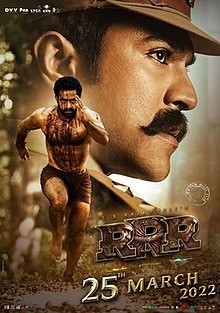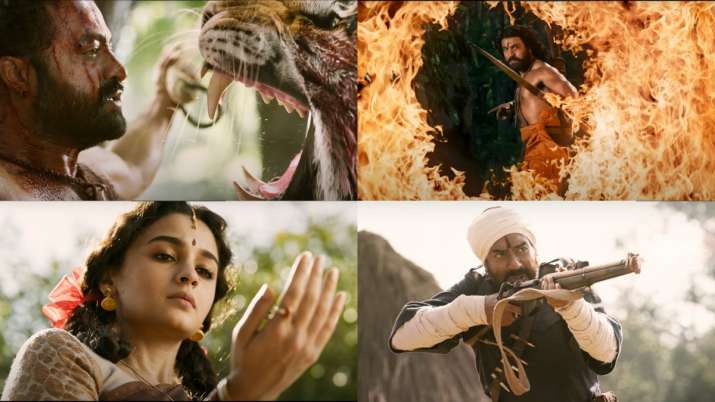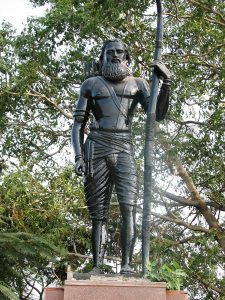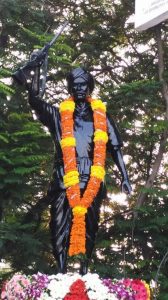
Sitarama Raju & Komaram Bheem: The real-life heroes behind Rajamouli's 'RRR'

SS Rajamouli’s RRR, a pan-India celluloid extravaganza, which is doing brisk business at the box-office even pushing The Kashmir Files to the second spot, ends up overshadowing the lives of the legendary tribal leaders that it is based on.
The film is so humungous in scale and ambition that it quite forgets the true exploits of the real life heroes, who were the inspiration behind this sweeping saga. These two tribal leaders, who had put up a tough resistance against the British with weapons like the “bow and arrow”, however, gets subsumed in this hyper-heroic drama. And, the audience outside the Telugu states, will not be any wiser about the two real-life revolutionaries – Alluri Sitarama Raju (1897-1924) and Komaram Bheem (1900-1940), after watching RRR.

In reality, the lives of these two rebels, who shook up the British empire, is inspiring. Both hailed from different areas, while Sitarama Raju had fought against the British Raj in the border areas of east Godavari and Vishakapatnam of the then Madras Presidency, which currently lies in Andhra Pradesh, Komaram Bheem had locked horns with the British in the region which is Telangana today. The Federal tracks the lives of these real-life heroes:
Hero of the jungle

Alluri Sitarama Raju, locally known as ‘manyam veerudu’ (hero of the jungle), was born in a middle-class family in a village called Pandrangi in Vishakapatnam. In 1882, the British introduced the Madras Forest Act, which alienated tribals from their home, the forests. The Act was later renamed as the Tamil Nadu Forest Act.
One of the main objectives of the Act was to prevent the forest dwellers from practicing slash and burn agriculture, which is locally known as the ‘podu’ system of agriculture. Under this Act, the tribal could only claim the watercourses, the pasture and forest produce but they could not clear forests for cultivation.
In order to oppose this Act, the educated Sitarama Raju, who lead a life like an ascetic and was always clad in saffron, started to mobilise the tribals. He worked among them for many years, learnt their culture, created awareness among the tribals and got accepted as one among them.
Also read: RRR movie review: NTR, Ram Charan pack a punch in Rajamouli’s emotional-action entertainer
In 1922, he led the Gudem rebellion attacking the Chintapalle police station in the coastal city of Vishakapatnam. But that was not the first time his men and he had ransacked police stations. For many years, they continued to ambush police stations to assemble guns for their fight.
Unable to withstand the guérilla warfare of the tribals, the British brought in the Malabar Special Reserve, who were trained in this type of warfare. They could still not nab him for another two years. In 1924, Sitarama Raju was caught and killed. This rebellion is also known as ‘manyam fituri’ and the Rampa rebellion. In memory of Sitarama Raju, a life-size statue has been erected in many parts of AP. The film RRR too features a statue of this rebel in one of the scenes.
According to Dr J Mangamma, biographer of Alluri Sitarama Raju, very little research has been done on this rebellion and not a single work is available in any language other than Telugu.
Fictionalising facts
In RRR, the role of Sitarama Raju was played by Ram Charan. Rajamouli has taken the creative license to blend fact with fiction in portraying Sitarama Raju. He has been portrayed as a police officer, which Sitarama Raju was not. His mission was to mobilise guns to fight the British Raj, which is shown in the film. Similarly, it is believed that Sitharama Raju had started to use his lover’s name Sita as a prefix to his name after her untimely death. In the film, however, a pining Sita continues to wait for Raju.
A section of Tamil film audience on social media unknowingly started to criticise Rajamouli accusing him of promoting Hindutva because he showed Sitarama Raju clad in saffron clothes and a thread across his chest with a strong resemblance to Rama from Ramayana. But in real life, Sitarama Raju was a saffron-clad rebel warrior.
Jal, Jangle, Jameen

Rama Rao junior, the other protagonist in RRR, has played the role of Komaram Bheem. Bheem, a Gond leader, who was born in Sankepalli of Adilabad district in Telangana. He had no proper schooling but he had the fighting spirit to save the tribals from the clutches of the British, a trait he imbibes from his father. His father was killed by the forest officials because he stood by the tribals fighting for their rights.
In 1940, after his face-off with the Nizam of Hyderabad’s men, which results in Bheem killing an official, he has to flee. He finally reaches Assam and starts to work in a tea plantation. During this time, he hears about the exploits of Alluri Sitarama Raju but it is not clear whether he tried to meet him or sought his help. However, in RRR, Bheem seeks support from Sitarama Raju, which Rajamouli himself admitted in interviews that this is not what happened in real life.
In Assam, Bheem fights for the rights of tea plantation workers and lands up in jail. Within a couple of days, he escapes from the lock-up and heads back home. Thereafter, he makes Jode Ghat as his hideout and continues the guérilla warfare against both the Nizams and the British between 1928 and 1940.
Also read: Ahead of release, PVR launches NFT of RRR
It was at this time that he raises the slogan ‘Jal, Jangle, Jameen’ (water, forest and land), demanding the basic rights of tribals. After three years of trying to hunt him down, the Nizam’s men find Bheem and kill him in 1940.
In RRR, Bheem is shown as a Gond leader but his mission is different – he wants to save a minor Gond girl who has been taken by British officials as a slave. When the film’s teaser was released, people objected without knowing the facts that Bheem was wearing a Muslim skull cap.
With both Ram Charan and Rama Rao junior putting in all their energy into the film to make it work, the film has become a box-office hit. It is expected more literature and cinema on these tribal leaders will emerge in the near future. Already, a new book in Tamil on Komaram Bheem penned by Sahu and Allam Rajaiah, has been published by Chinthan Books. It was one of the books, which was highly-sought after, at the recently concluded Chennai Book Fair.
As far as films are concerned, two Telugu films have already been made on these icons. In 1974, Alluri Seetarama Raju by V Ramachandra Rao, was released and got a National award for best lyrics and in 1990, the film Komaram Bheem by Allani Sridhar was released and fetched two Nandi Awards.


